Charts of the Week
Charts of the week from 15 to 19 May 2023: gross domestic product, activity in construction, current account of the balance of payments, value of fiscally verified invoices, electricity consumption and other charts
In the first quarter of this year, real gross domestic product increased by 0.6% quarter-on-quarter and by 0.7% year-on-year. Growth in economic activity was driven by household consumption, construction investment and growth in most services, where the post-COVID-19 recovery continues in some sectors, while activity in the export-oriented part of the economy remained weak. The value of construction put in place increased at the beginning of the year in all segments and was 24% higher year-on-year in the first quarter. The current account of the balance of payments showed a surplus in the first quarter. Amid a sharp decline in goods imports, the surplus was mainly the result of the goods trade balance. In the first half of May, the nominal value of fiscally verified invoices was similar to the same period last year. Turnover in trade declined slightly year-on-year, but growth in accommodation and food service activities remained relatively strong. Electricity consumption was down in all consumer groups in April, most markedly in industry. Slovenian industrial producer prices fell month-on-month in April, after about two and a half years of uninterrupted growth. Year-on-year growth also slowed further (to 9.9%). The number of persons in employment continued to rise in the first quarter, again mainly due to the employment of foreigners.
Gross domestic product, Q1 2023
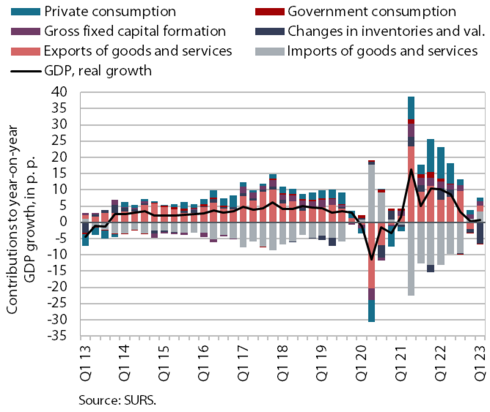
In the first quarter of this year, real gross domestic product (GDP) increased by 0.6% quarter-on-quarter and by 0.7% year-on-year. Household consumption contributed more than one percentage point to year-on-year GDP growth in the first quarter. Compared to the same period last year, households spent more on tourist services abroad and vehicle purchases, and less on food, non-food products and overnight stays in Slovenia. As the number of arrivals and overnight stays of foreign tourists increased, growth in tourism-related services was strong. Investment activity remained relatively strong in the first quarter, with a particular acceleration of activity in construction. However, the surprisingly high negative contribution of inventories (-6.5 p.p.) contributed to the sharp year-on-year decline in gross capital formation. Activity in the export-oriented part of the economy was weak in the first quarter, with goods exports and manufacturing activity remaining at similar levels to the same period last year. Trade in services, especially travel, increased, supported by a rapid post-COVID-19 recovery in tourism. Total exports increased while total imports declined, contributing to the high positive contribution of the external balance (5.1 p.p.). After a period of robust growth, government consumption declined year-on-year for the third consecutive quarter, especially related to lower spending on containment measures.
Activity in construction, March 2023
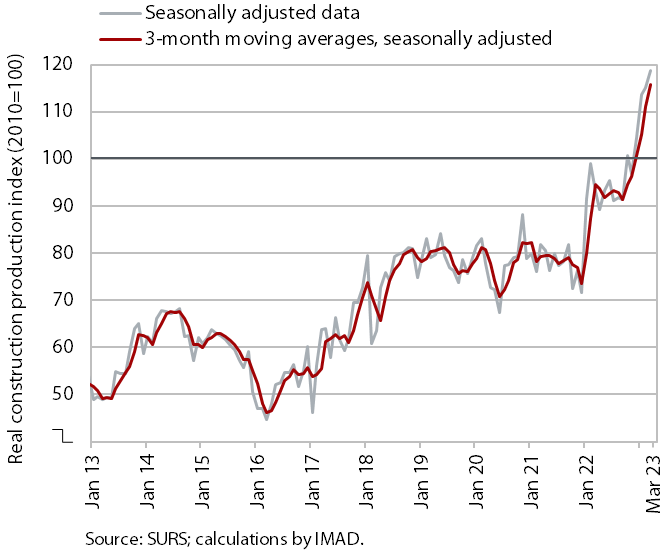
According to data on the value of construction work put in place, construction activity further increased in March. The value of construction work put in place increased sharply at the beginning of this year and was 28% higher year-on-year in March. Activity in the first quarter was 24% higher than in the first quarter of last year, with a similar growth in all three segments covered by the statistics: construction of buildings, civil engineering, and specialised construction activities. The implicit deflator of the value of construction work put in place used to measure prices in the construction sector was 9% in March, the lowest level since the beginning of 2022.
However, some other data suggest significantly lower growth in construction activity. According to VAT data, the activity of construction companies in March was 6% higher than last year. Based on data on the value of construction put in place, the difference in the activity growth was 22 p.p. Data on the value of industrial production in two activities traditionally strongly linked to construction also do not point to such high growth.
Current account of the balance of payments, March 2023
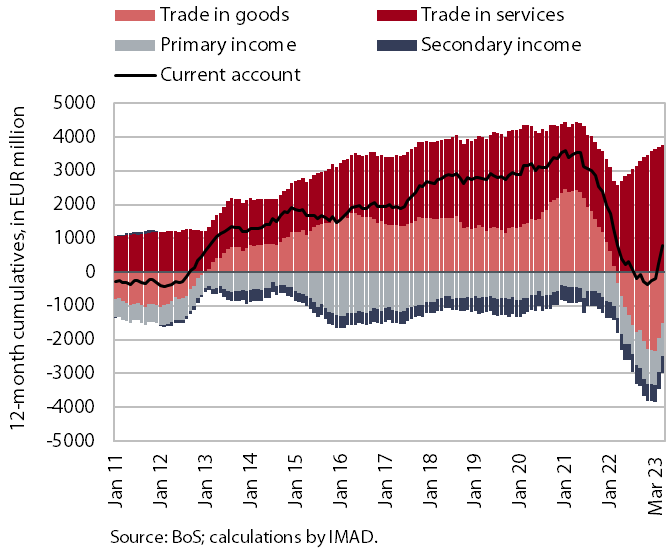
The current account of the balance of payments recorded a surplus in the first quarter of this year. The largest contribution came from the trade balance, which turned from a deficit to a surplus. In the first quarter, goods exports rose slightly year-on-year while imports fell significantly, and the terms of trade improved. We estimate that the quantity fluctuations contributed EUR 619 million to the year-on-year change in the balance of goods trade (EUR 789 million) and the terms of trade contributed EUR 170 million. The growth in the services surplus continued, especially in trade in transportation services, as their exports increased year-on-year, while imports declined. In the first quarter, net outflows of primary and secondary income were slightly lower year-on-year than a year ago. The primary income deficit was lower due to higher net interest receipts by the government and the Bank of Slovenia from deposits in foreign accounts, while the secondary income deficit was lower due to higher transfers from abroad to the domestic private sector. The 12-month balance of the current account of the balance of payments showed a surplus of EUR 784.1 million in March (1.2% of estimated GDP).
Value of fiscally verified invoices, in nominal terms, 30 April–13 May 2023
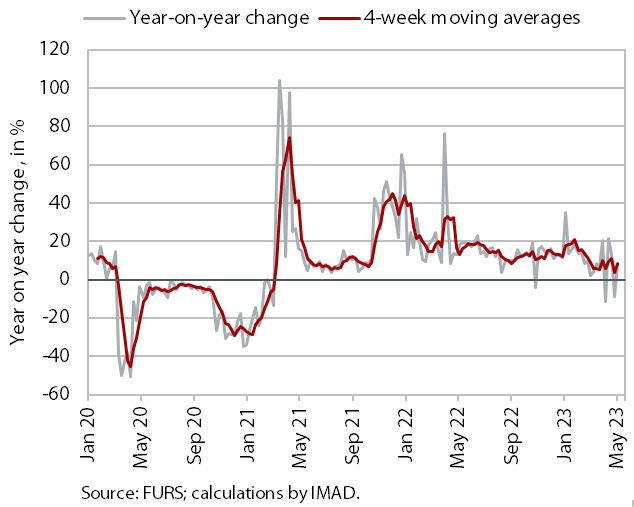
With one working day less this year, the nominal value of fiscally verified invoices between 30 April and 13 May 2023 was similar to the same period last year. The fluctuations in year-on-year growth at the end of April and beginning of May were mainly influenced by the timing of the Labour Day holidays and the last working day before the holidays. After nominal growth in the previous 14-day period was the highest since January this year, which was also due to this year’s increased purchases before the holidays, turnover between 30 April and 13 May was similar to the same period last year, with one working day less this year. Turnover in trade decreased by 1% year-on-year and accounted for 76% of the total value of fiscally verified invoices. Turnover growth in accommodation and food service activities remained similar to the previous 14-day period (11%).
Electricity consumption by consumption group, April 2023
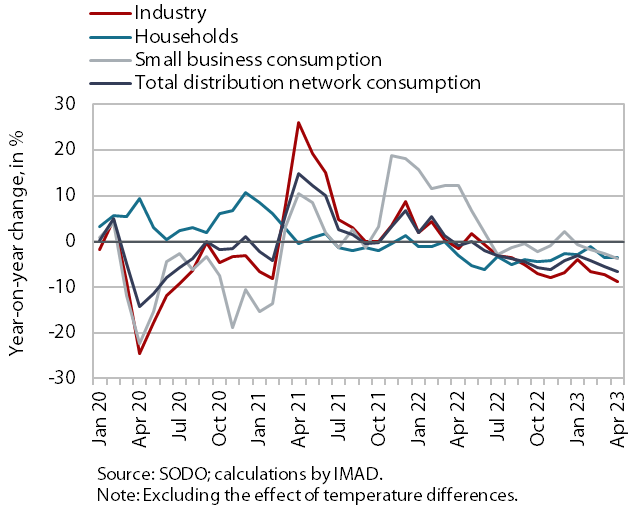
In April, electricity consumption in the distribution network was lower year-on-year in all consumption groups, with one fewer working day this April. The sharpest decline was in industrial consumption (by 8.8%), which we estimate to be due to one fewer working day this year and lower consumption in the energy-intensive part of the economy as a result of high energy prices. Household consumption was also lower in April than a year earlier (by 3.5%), according to our estimates due to a more rational energy consumption and the impact of the COVID-19 epidemic on last year’s high base. Small business consumption was 3.8% lower year-on-year in April.
Slovenian industrial producer prices, April 2023
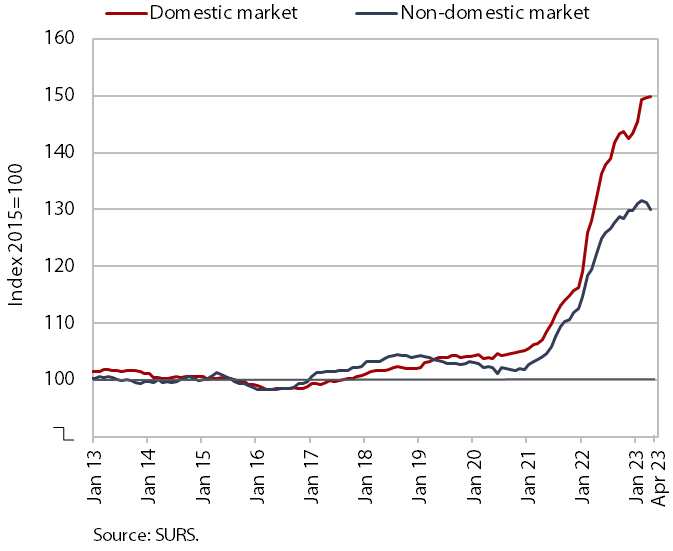
After about two and a half years of uninterrupted growth, Slovenian industrial producer prices fell month-on-month in April (-0.4%); the year-on-year growth thus continues to slow rapidly. Prices of products fell month-on-month in almost all industrial groups, with the exception of non-durable consumer goods, where prices rose by 0.5%. Prices on foreign markets fell for the second month in a row (this time by 0.9%), while prices on the domestic market were only marginally higher (by 0.1%) due to the increase in consumer goods prices. Against the backdrop of the monthly decline in prices and the high base from last year, the year-on-year price increase for Slovenian producer prices slowed down significantly (from 13.4% in March), but still reached 9.9%. Growth was lower on both the domestic (by 13.3%) and foreign markets (by 6.4%). Year-on-year product price growth is slowing down in all product groups and remains highest in the energy group (36.1%). In the intermediate goods group, year-on-year price growth fell to 6.5%.
Number of persons in employment, March 2023
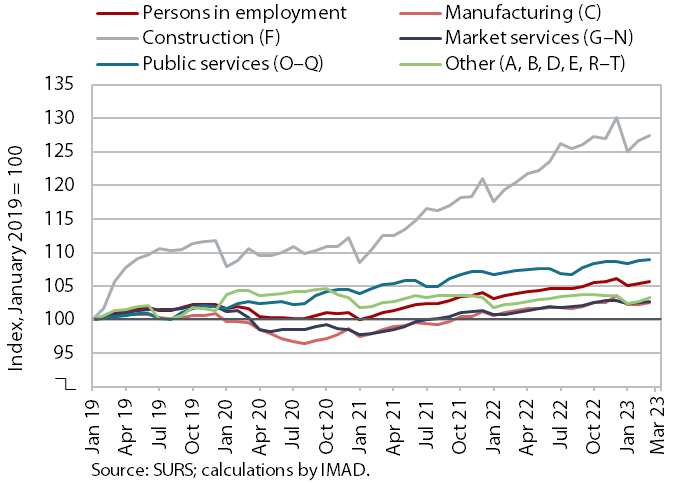
In March, year-on-year growth in the number of persons in employment was similar to the previous two months (1.8%). The strongest growth was still seen in construction, which is facing a major labour shortage and saw the largest increase in the number of persons in employment also compared to the same period in 2019. Employment of foreign workers has been the largest contributor to the overall growth in the number of persons in employment for some time – their contribution was 83% year-on-year in March, slightly higher than in previous months. Foreigners accounted for 14.2% of total employment, up 1.3 p.p. from the previous year. The sectors with the highest share of foreigners were construction (48%), transportation and storage (32%), and administrative and support service activities (26%).
